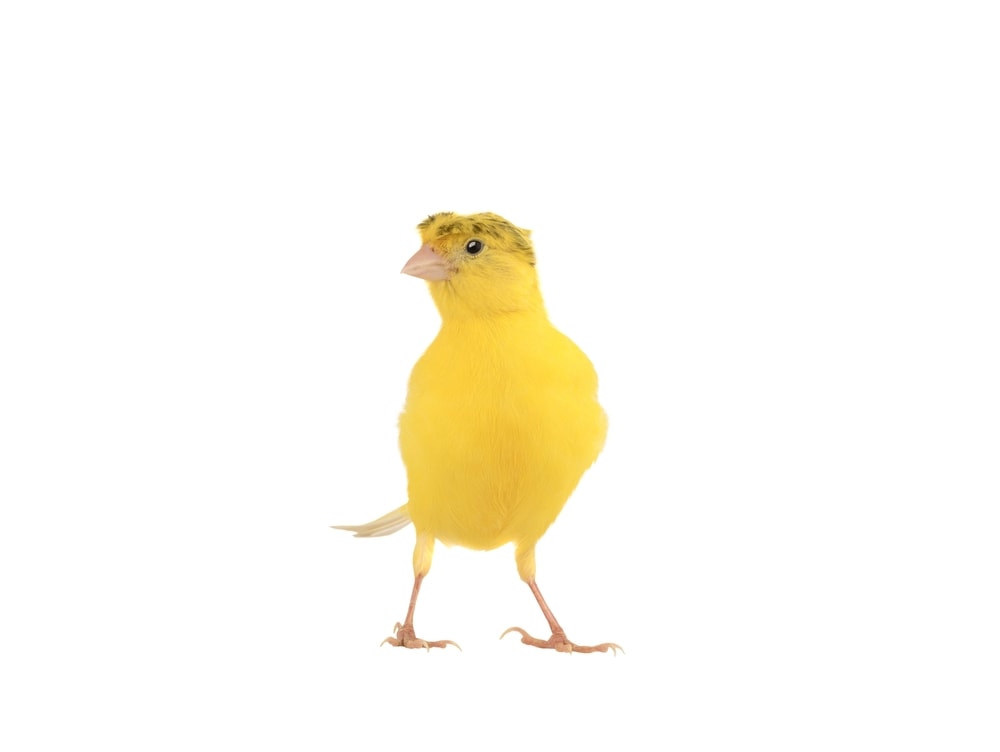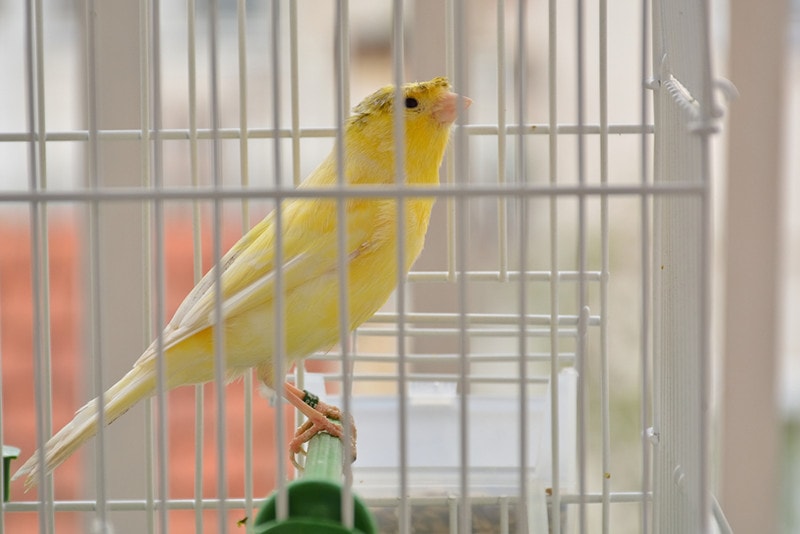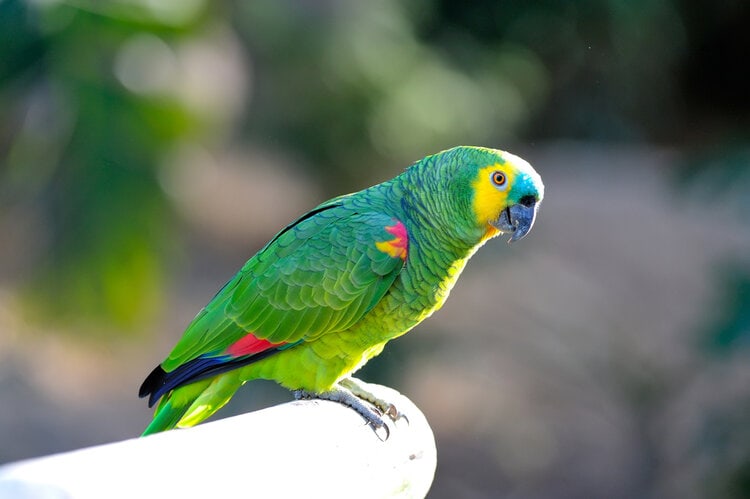Click to Skip Ahead
While some domestic canaries are bred for their songs or colors, the crested canary is a “type” canary. These birds are bred for their form or shape, and in the case of the crested canary, its desirable trait is the tuft of feathers around the top of its head. This tuft is what gives the breed its name. This bird is popular because of its unusual look, and crested variants of Lancashire, Norwich, and Gloster canaries are readily available from breeders and pet shops.
Available in a range of colors, the crested canary has similar care requirements to those of other canaries.

Species Overview
| Common Names: | Crested canary |
| Scientific Name: | Serinus canaria domesticus |
| Adult Size: | 5 inches |
| Life Expectancy: | 10–15 years |
Origin and History
The feathers of the crested canary are a mutation, which first appeared in the late 18th century. The affected bird was bred with other canaries to recreate the mutation and to produce a line of birds with the same crest. By the 1800s, the crested canary had become quite popular and gained the nickname, the “King of the Fancy.” However, ideal examples of the bird, which at the time had a clear yellow body and dark crest, attracted high prices as a result of this popularity. This meant typical owners were unable to afford the birds, and numbers dwindled.
True crested canaries are difficult to come by, but the smaller crested Gloster canaries are widely available, along with the crested variants of the Lancashire and Norwich canaries.

Temperament
Canaries tend to be shy and timid birds. They prefer to be left alone in their cage rather than handled, and attempting to handle one can lead to stress. However, some owners report successful handling if they start when the bird is young and regularly handle it. If you do want to try handling your bird, ensure that all doors and windows are closed before opening the cage door, or your canary will likely escape.
Although they are quite shy, canaries do like the company of their owners. They will watch their humans go about their business and will sing for them. Some do prefer solitude, however, and if your bird gets anxious when you are in the room, you may need to look for a quieter area to ensure that it does not get stressed or anxious.
You can let a canary out of its cage for exercise. This should only be done if the room is fully secure, though. Close doors and windows, and make sure there are no other pets in the room. You should also cover windows and mirrors to prevent your canary from flying into them.
Canaries can be kept individually, though some owners do report success in housing two or even more canaries in the same cage. That said, housing two males together may lead to fights.
- Sweet and playful
- Can have a pretty song
- Somewhat unusual tufted head feathers
- Crested variants of different canary species available
- Needs a large cage
- Doesn’t usually enjoy being handled
- True crested canaries can be difficult to find
Speech & Vocalizations
Crested canaries are not bred for their songs or vocalizations. This means you may get one that is relatively quiet or one that sings whenever you’re in the room. The song tends to be tuneful and pretty, with male canaries more likely to sing than females. Canaries also warble, chatter, chirp, and squeak, so there is a good variety of vocalization types.
Crested Canary Colors and Markings
True crested canaries are not bred for their particular markings or color, which means that they can have any color. However, this variation is rare. Crested variants of Gloster, Lancashire, and Norwich canaries are more commonly found.
- Crested canary: True crested canaries tend to be quite large and stocky. Although the original preference for colors was a pure yellow body and a dark tuft, this is not necessarily the case anymore. These birds can come in a variety of colors.
- Gloster canary: Glosters tend to be smaller than true crested canaries, but they can also come in a variety of colors.
- Lancashire canary: Although they can be different colors, the Lancashire canary tends to be yellow. It has a small body and a long tail.
- Norwich canary: Norwich canaries have round bodies, and they tend to come in the original orange and red, along with white, clear, and variegated.
Caring for the Crested Canary
First and foremost, canaries need space. Their cages appear large compared to their size, as you need to provide something that is at least 2 to 3 feet tall and has multiple horizontal perches. They need food and water bowls, mirrors, and toys, along with a water bowl in which they can bathe.
Diet
Most owners feed their canaries a commercial pellet diet, following the manufacturer’s guidelines for feeding amounts. You can also serve vegetables, including kale, beans, and parsley. Always ensure that your canary has access to fresh water for drinking and a separate water area for bathing.
Exercise
Canaries do benefit from regular exercise. Even if you have a flight cage, which offers more room for your bird to spread its wings and take flight, you can open the cage door and allow them to fly around the room. When doing so, ensure that there are no other pets in the room, close all windows and doors, and cover windows and any mirrors. Your canary will likely seek the comfort of their cage or perch when they have had enough exercise.
Common Illnesses
Respiratory illness can be quite common in canaries. Ideally, you will keep yours in an environment free from toxins and smoke, so not in a kitchen. Airsac mites can also be transmitted from infected birds. These initially cause an otherwise vocal bird to stop singing, and eventually, they will start coughing and sneezing. This can prove fatal. Some fungal diseases and bacterial infections are also common in canaries.

Where to Adopt or Buy a Crested Canary
True rested canaries are rare and can be difficult to find. Most buyers get their birds from known breeders. Check with specialist breeders for recommendations, and look online to find reputable and reliable crested canary breeders.
Other types of tufted canaries, such as Norwich and Gloster canaries, are more common. They can often be found in pet shops and from breeders. Search online, visit a local pet store or bird store, or ask fellow keepers where they got their crested canaries to find a reliable source.

Summary
The crested canary is bred for the tufted crown of feathers on the top of its head. This feature means they stand out from other types of canaries, but pure crested canaries are difficult to find, typically only being found at specialist breeders. Crested Gloster, Norwich, and Lancashire canaries have the same crested feathers but are more readily available from breeders and can even be found in some pet stores.
See also:
Featured Image Credit: Emmily, Shutterstock










